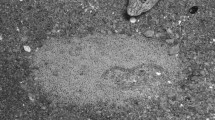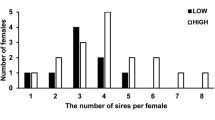Abstract
Mating behaviour and mating patterns are affected to a large extent by body size in both hermaphrodites and gonochorists. Detailed research on mating patterns, mate choice, pre- and post-copulatory sexual selection in marine pulmonates is wanting, thus warranting more attention as a study system in the future. The simultaneous hermaphroditic limpet Siphonaria capensis (Pulmonata: Basommatophora) shows size-dependent fecundity, and acts as a suitable organism to test the effects of body size on mating patterns, mating success, gender expression and reciprocity in hermaphroditic marine gastropods. We mainly used bootstrap resampling techniques to estimate the effects of different factors on mating patterns. In the populations studied, a strong size-assortative mating pattern was observed, where small-scale spatial distribution of potential mating partners (the mate availability hypothesis) could explain 65% of this pattern, while mate choice and mating constraints explaining the rest. No significant difference in mating success between limpets with different body size was found, even though in one population, the sperm recipients were larger than the non-copulating limpets. Interestingly, we found that intromission was non-reciprocal during copulations. This may mean that this species does not conform to the common rule of reciprocity predicted for hermaphrodites, unless there is sex-role alternation between individuals in a mating pair. The mating partners consisted of similar sized, acting males and females, thus without any indication of the body size determining the gender expression. The matings took place in early mornings only at spring tides and the animals were observed laying egg masses only during neap tides. Since siphonariid limpets possess both a spermatheca and a seminal vesicle, which may have either a sperm storing and/or digestive function, post-copulatory sexual selection (e.g., sperm competition) cannot be dismissed.

Similar content being viewed by others
References
Abe N (1940) The homing, spawning and other habits of a limpet, Siphonaria japonica Donovan. Tohoku Univ Sci Rep 15:59–95
Angeloni L (2003) Sexual selection in a simultaneous hermaphrodite with hypodermic insemination: body size, allocation to sexual roles and paternity. Anim Behav 66:417–426
Angeloni L, Bradbury JW, Charnov EL (2002) Body size and sex allocation in simultaneously hermaphroditic animals. Behav Ecol 13:419–426
Berry AJ (1977) Gastropoda: Pulmonata. In: Giese AC, Pearse JS (eds) Reproduction of marine invertebrates. Academic Press, New York, pp 181–226
Bateman AJ (1948) Intra-sexual selection in Drosophila. Heredity 2:349–368
Baur B (1998) Sperm competition in molluscs. In: Birkhead TR, Møller AP (eds) Sperm competition and sexual selection. Academic Press, London, pp 255–305
Branch GM, Cherry MI (1985) Activity rhythms of the pulmonate limpet Siphonaria capensis Q. and G. as an adaptation to osmotic stress, predation and wave action. J Exp Mar Biol Ecol 87:153–168
Casella G, Berger RL (2002) Statistical inference, 2nd edn. Duxbury Press, Belmont, CA
Chambers RJ, McQuaid CD (1994) Notes on taxonomy, spawn and larval development of South African species of the intertidal limpet genus Siphonaria (Gastropoda: Pulmonata). J Moll Stud 60:263–275
Charnov EL, Maynard-Smith J, Bull JJ (1976) Why be a hermaphrodite? Nature 263:125–126
Charnov EL (1979) Simultaneous hermaphroditism and sexual selection. Proc Natl Acad Sci USA 76:2480–2484
Charnov EL (1996) Sperm competition and sex allocation in simultaneous hermaphrodtes. Evol Ecol 10:457–462
Crespi BJ (1989) Causes of assortative mating in arthropods. Anim Behav 38:980–1000
DeWitt TJ (1991) Mating behaviour of the freshwater pulmonate snail, Physa gyrina. Am Malacol Bull 9:41–45
DeWitt TJ (1996) Gender contests in a simultaneous hermaphrodite snail: a size-advantage model for behaviour. Anim Behav 51:345–351
Edwards DC (1969) Zonation by size as an adaptation for intertidal life in Olivella biplicata. Am Zool 9:399–417
Erlandsson J, Johannesson K (1994) Sexual selection on female size in a marine snail, Littorina littorea (L.). J Exp Mar Biol Ecol 181:145–157
Erlandsson J, Rolán-Alvarez E (1998) Sexual selection and assortative mating by size and their roles in the maintenance of a polymorphism in Swedish Littorina saxatilis populations. Hydrobiologia 378:59–69
Fischer EA (1984) Egg trading in the chalk bass, Serranus tortugarum, a simultaneous hermaphrodite. Z Tierpsychol 66:143–151
Fisher RA (1958) The genetical theory of natural selection. Dover, New York
Forbes MRL, Pagola H, Baker RL (1992) Causes of non-random pairings by size in the brine shrimp, Artemia salina (Crustacea: Anostraca). Oecologia 91:214–219
Ghiselin MT (1969) The evolution of hermaphroditism among animals. Quat Rev Biol 44:189–208
Gianguzza P, Badalamenti F, Jensen KR, Chemello, Cannicci S, Riggio S (2004) Body size and mating strategies in the simultaneous hermaphrodite Oxynoe olivacea (Mollusca, Opisthobranchia, Sacoglossa). Funct Ecol 18:899–906
Gray DR, Hodgson AN (1997) Temporal variation in foraging behaviour of Patella granularis (Patellogastropoda) and Siphonaria concinna (Basommatophora) on a South African shore. J Moll Stud 63:121–130
Greeff JM, Michiels NK (1999a) Low potential for sexual selection in simultaneously hermaphroditic animals. Proc R Soc Lond Ser B 266:1671–1676
Greeff JM, Michiels NK (1999b) Sperm digestion and reciprocal sperm transfer can drive hermaphrodite sex allocation to equality. Am Nat 153:421–430
Haase M, Karlsson A (2004) Mate choice in a hermaphrodite: you won’t score with a spermatophore. Anim Behav 67:287–291
Heller J (1993) Hermaphroditism in molluscs. Biol J Linn Soc 48:19–42
Hirano Y, Inaba A (1980) Siphonaria (Pulmonate limpet) Survey of Japan. I. Observations on the behaviour of Siphonaria japonica during breeding season. Publ Seto Mar Biol Lab 25:323–334
Hodgson AN (1999) The biology of siphonariid limpets (Gastropoda: Pulmonata). Oceanogr Mar Biol: Ann Rev 37:245–314
Hubendick B (1978) Systematics and comparative morphology of Basommatophora. In: Fretter V, Peake J (eds) Pulmonates. Academic Press, London, pp 1–47
Koene JM, Ter Maat A (2005) Sex role alternation in the simultaneously hermaphroditic pond snail Lymnaea stagnalis is determined by the availability of seminal fluid. Anim Behav (In Press)
Leonard JL (1990) The hermaphrodites’s dilemma. J Theor Biol 147:361–372
Levings SC, Garrity SD (1986) Notes on reproduction of a tropical pulmonate limpet, Siphonaria gigas (Sowerby). Veliger 29:86–90
Lüscher A, Milinski M (2003) Simultaneous hermaphrodites reproducing in pairs self-fertilize some of their eggs: an experimental test of predictions of mixed-mating and Hermaphrodite’s Dilemma theory. J Evol Biol 16:1030–1037
Lüscher A, Wedekind C (2002) Size-dependent discrimination of mating partners in the simultaneous hermaphroditic cestode Schistocephalus solidus. Behav Ecol 13:254–259
Michiels NK (1998) Mating conflicts and sperm competition in simultaneous hermaphrodites. In: Birkhead TR, Møller AP (eds) Sperm competition and sexual selection. Academic Press, London, pp 219–254
Michiels NK, Hohner A, Vorndran IC (2001) Precopulatory mate assessment in relation to body size in the earthworm Lumbricus terrestris: avoidance of dangerous liaisons? Behav Ecol 12:612–618
Morgan MT (1994) Models of sexual selection in hermaphrodites, especially in plants. Am Nat 144:100–125
Ohbayashi-Hodoki K, Ishihama F, Shimada M (2004) Body size-dependent gender role in a simultaneously hermaphroditic freshwater snail, Physa acuta. Behav Ecol 15:976–981
Oliver AS (1997) Size and density dependent mating tactics in the simultaneously hermaphroditic seabass Serranus subligarius (Cope, 1870). Behaviour 134:563–594
Pal P, Hodgson AN (2002) An ultrastructural study of oogenesis in a planktonic and a direct developing species of Siphonaria (Gastropoda: Pulmonata). J Moll Stud 68:337–344
Pal P, Hodgson AN (2003) The structure of the egg ribbons of a planktonic and intracapsular developing siphonariid limpet (Gastropoda: Pulmonata). Inv Reprod Dev 43:243–253
Pal P (2003) A comparative study of egg development in two species of siphonariid limpets with contrasting developmental modes. PhD thesis, Rhodes University
Pal P, Hodgson AN (2005) Reproductive seasonality and simultaneous hermaphroditism in two species of Siphonaria (Gastropoda: Pulmonata): from the Southeast coast of South Africa. J Moll Stud 71:33–40
Peters A, Michiels NK (1996) Do simultaneous hermaphrodites choose their mates? Effects of body size in a planarian flatworm. Fresh Biol 36:623–630
Petersen CW (1995) Reproductive behavior, egg trading, and correlates of male mating success in the simultaneous hermaphrodite, Serranus tabacarius. Env Biol Fish 43:351–361
Pongratz N, Michiels NK (2003) High multiple paternity and low last-male sperm precedence in a hermaphroditic planarian flatworm: consequences for reciprocity patterns. Mol Ecol 12:1425–1433
Puurtinen M, Kaitala V (2002) Mate-search efficiency can determine the evolution of separate sexes and the stability of hermaphroditism in animals. Am Nat 160:645–660
Quinn GP, Keough MJ (2002) Experimental design and data analysis for biologists. Cambridge University Press, Cambridge
Ridley M (1983) The explanation of organic diversity. The comparative method and adaptations for mating. Clarendon Press, Oxford
Rolán-Alvarez E, Erlandsson J, Johannesson K, Cruz R (1999) Mechanisms of incomplete prezygotic reproductive isolation in an intertidal snail: testing behavioural models in wild populations. J Evol Biol 12:879–890
Rolán-Alvarez E, Caballero A (2000) Estimating sexual selection and sexual isolation effects from mating frequencies. Evolution 54:30–36
Rowe L, Arnqvist G (1996) Analysis of causal components of assortative mating in water striders. Behav Ecol Sociobiol 38:279–286
Schärer L, Karlsson LM, Christen M, Wedekind C (2001) Size-dependent sex allocation in a simultaneous hermaphrodite parasite. J Evol Biol 14:55–67
Sisodia S, Singh BN (2004) Size-dependent sexual selection in Drosophila ananassae. Genetica 121:207–217
Sokal RR, Rohlf FJ (1995) Biometry. Freeman and company, New York
Stone J, Björklund M (2002) Delayed prezygotic isolating mechanisms: evolution with a twist. Proc R Soc Lond Ser B 269:861–865
Tomlinson J (1966) The advantage of hermaphroditism and parthenogenesis. J Theor Biol 11:54–58
Underwood AJ (1997) Experiments in ecology: their logical design and interpretation using analysis of variance. Cambridge University Press, Cambridge
Vreys C, Michiels NK (1997) Flatworms flatten to size up each other. Proc R Soc Lond Ser B 264:1559–1564
Zar JH (1974) Biostatistical analysis. Prentice-Hall, New Jersey
Acknowledgements
We would like to thank Alan N. Hodgson, Kerstin Johannesson, Lars Pettersson, John Christy and two anonymous referees for their comments on earlier versions of the manuscript. This study was financially supported by a post-doctoral fellowship to J.E from Rhodes University, South Africa. The present study conforms to the current laws of South Africa.
Author information
Authors and Affiliations
Corresponding author
Additional information
Communicated by M. Kühl, Helsingør
Appendices
Appendix 1
Appendix 2
Rights and permissions
About this article
Cite this article
Pal, P., Erlandsson, J. & Sköld, M. Size-assortative mating and non-reciprocal copulation in a hermaphroditic intertidal limpet: test of the mate availability hypothesis. Marine Biology 148, 1273–1282 (2006). https://doi.org/10.1007/s00227-005-0173-4
Received:
Accepted:
Published:
Issue Date:
DOI: https://doi.org/10.1007/s00227-005-0173-4




